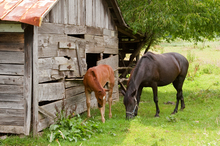According to Krishona Martinson, of the University of Minnesota, horse owners transitioning horses to spring pastures can take steps to both maximize horse health and also maintain healthy pastures, not only for the spring season, but for all year.

Maintaining horse and pasture health
While it is tempting to turn horses out into spring pastures at the first sight of green grass, especially after a long winter, a carefully considered transition will support horse health and maintain best pasture practices.
Spring grazing should be introduced slowly and delayed until grasses reach 6 to 8â in height to optimize both the health of the horse and pasture. It is tempting to turn horses out into spring pastures at the first sight of green grass, especially after a long winter.
However, spring grazing should be introduced slowly and delayed until grasses reach 6 to 8â in height to optimize both the health of the horse and pasture.
When horse pastures reach 6 to 8â, begin grazing for 15 minutes, increasing the grazing time each day by 15 minutes until 4 to 5 hours of consecutive grazing is reached. After that, unrestricted or continuous grazing can resume.
It is also recommended to feed horses their normal hay diet before turning them out to pasture during the first several grazing events of the year along with time restrictions. This strategy should help avoid rapid intake of pasture grasses which can lead to gastrointestinal upsets with serious consequences .
Change horse feedstuffs gradually:
Although hay and pasture are both forms of forages, there are significant differences. Dried hay is approximately 15% moisture compared to fresh pasture that is 85% moisture. The horse is a hind-gut, fermenting herbivore that relies extensively on the microbes present in its gastrointestinal tract to be able to process forages.
The microbes are a mix of different organisms that work together to the benefit of the horse. If the feedstuffs the microbes are utilizing change suddenly, there may be too little time for the microbial populations to adjust to the change. Instead, large numbers of them die, while others flourish, setting up a situation where toxins may be absorbed by the horse, resulting in digestive dysfunction and possibly colic.
A gradual change from one feedstuff to another provides enough time for the microbial populations to adjust.
Manage pastures to reduce the chance of laminitis:
Laminitis is a painful, disabling, common, and costly disease of the horse and pony that has many causes. Annual incidence of laminitis in the U.S. is reported to be 2%, but this rises to about 5% in the spring and summer.
Nearly half of all reported cases of laminitis in the U.S. occur in animals at pasture. During photosynthesis, green plants produce simple sugars. When sugars are produced in excess of the energy requirement of the plant for growth and development, they are converted into storage, or "reserve" carbohydrates. Storage of carbohydrates is commonly seen during the rapid growth of spring.
The vegetative tissues of cool season pasture grasses (i.e. timothy, orchardgrass, bromegrass) accumulate fructan as a component of their reserve carbohydrate, which is stored in the stem until required by the plant as an energy source. The sum of the simple sugars, fructan, and starch comprises the nonstructural carbohydrate (NSC) fraction of the plant.
There is some evidence of association, and even stronger evidence of causation between laminitis and rapid intake (and total intake) of NSC. Furthermore, administering high concentrations of fructan to horses has resulted in laminitis.
Why is so much emphasis placed on fructan and spring grazing?
Seasonal variations in pasture carbohydrates are well documented. In European studies, concentrations of fructan concentrations were highest in the spring, lowest in summer, and intermediate in the fall. Because horses are selective grazers, and are known to find feedstuffs with elevated sugar content highly palatable, avoiding or restricting grazing in the early spring can reduce the chance of rapid NSC intake and laminitis.
Seek veterinarian approval before grazing horses susceptible to (or with previous episodes of) laminitis as some horses cannot tolerate any grazing.
Preserving horse pasture health:
Pasture grasses need sufficient growth before grazing is allowed. Photosynthesis (the process of converting solar energy to chemical energy) occurs mainly within the leaves of plants. If the leaves are grazed too early (prior to 6â tall) or too often, plants can lose vigor, competitiveness, and root structure due to the lack of photosynthetic ability. This will lead to eventual die back and overgrazed areas being replaced by undesirable plant species or weeds.
Grazing should cease when forages have been grazed down to 3 to 4 inches. At this time, move horses to another paddock or a dry lot. Grazing can resume when grasses regrow to 6 to 8â. On average, 2 to 3 acres of well-managed pasture can provide the forage needs for one horse from spring to fall.
Conclusions:
It is critical to slowly introduce horses to spring pastures. When horse pastures reach 6 to 8â, begin grazing for 15 minutes, increasing the grazing time by 15 minutes each day until 4 to 5 hours of consecutive grazing is reached. Following this recommendation will help ensure both horse and pasture health.
